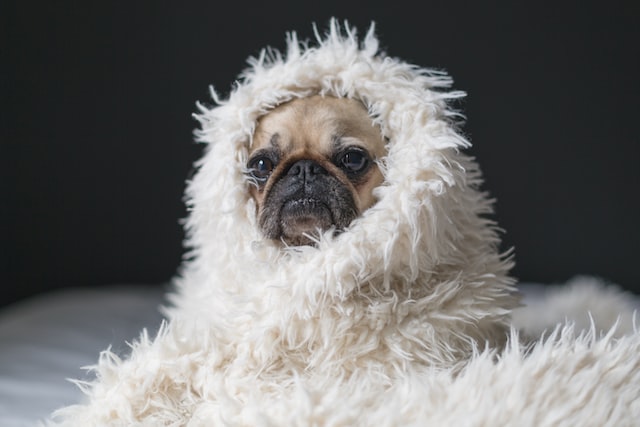Dogs are sensitive to colder temperatures, especially if they are breeds that are short-haired or have a thinner builds. In general, dogs are more sensitive to temperature changes than humans are, and they can become uncomfortable or even develop hypothermia if they are exposed to extreme cold for too long. During cold snaps, in particular below freezing, it is important to take steps to protect your dog from the cold, such as providing them with a warm and sheltered place to sleep, and limiting their time outdoors in extreme weather.

Staying warm outdoors
If you are taking your dog outdoors during the colder weather, here are some steps you can take to help them stay warm and comfortable:
- Keep walks, playtime and potty breaks to the minimum
- Feeding them a balanced diet to help maintain their body temperature and consider giving the access to extra food. Dogs burn more calories in the colder weather while outdoors.
- Cover their paws with dog boots or booties to protect them from the cold, ice & snow
- Provide them with a doggie jumper or coat, especially if they are short-haired or have a slight build.
It is important to monitor your dog’s behaviour and health when they are outdoors in cold weather, and to bring them inside if they seem to be struggling. If your dog generally sleeps outside in a kennel, consider brining them indoors for the colder nights or putting the kennel in a car free garage or utility room. If you are unsure about how to care for your dog in cold weather, you can talk to your vet for advice.
Signs your dog is cold
Dogs can show a variety of signs when they are cold, and these signs can vary depending on the severity of the cold and the individual dog (breed, age, weight, etc.). Some common signs that your dog is cold include:
- Shivering or trembling: This is a common sign that your dog is cold, and it occurs when their muscles contract to produce heat.
- Hunching or curling up: If your dog is cold, they may try to conserve heat by curling up into a ball, or by hunching close to the ground.
- Whining or barking: Some dogs will vocalise when they are cold, either by whining, barking, or making other noises.
- Loss of energy or enthusiasm: If your dog is cold, they may become less active and playful, and they may seem less interested in their surroundings.
- Slowing down or moving slowly: Cold weather can make it harder for dogs to move and stay warm, so they may slow down or move more slowly than usual.
- Seeking out warmth: If your dog is cold, they may try to find warmer areas or surfaces to lie on, such as a sunny spot on the floor or a cozy bed.
If you notice any of these signs in your dog, it’s important to take steps to warm them up and keep them comfortable. Remember to warm them up slowly, with blankets and heat sources.

Staying warm indoors
There are several steps you can take to help keep your dog warm when they are indoors. Some tips for keeping dogs warm indoors include:
- Providing them with a warm and sheltered place to sleep, such as a dog bed or crate,
- Using a high-quality, insulating dog bed or pad to provide extra warmth and cushioning. It is even possible to buy electrical heating pads for your dog, breeds like greyhounds love these sources of extra heat.
- Aim to keep your home well-heated, and maintaining a comfortable temperature at all times. Try to eliminate draughts as much as possible. We know that heating your whole house can prove expensive, try to maintain warmth in at least one room where you and the dogs can stay.
- Providing them with plenty of fresh, clean water to drink.
- Feeding them a balanced diet to help maintain their body temperature
- Using a humidifier to add moisture to the air, which can help prevent dryness and cracking of their skin, nose and paws.
- Providing them with a dog jumper or jacket, especially if they are short-haired or have a thin build
- Encourage your dog to play indoors and only take them outdoors for those necessary potty breaks.
Remember, every dog is different, and what works for one may not work for another.
Indoor games for your dog
During the colder weather here are some ideas for games to play indoors with a dog include:
- Hide and seek: This is a classic game that can be played indoors. To play, have someone hold your dog while you hide, then call their name and let them find you. You can also hide treats or toys for them to find.
- Indoor fetch: If you have a small space, you can still play fetch with your dog using a soft, indoor-safe ball or toy. Try playing in a hallway or a small room, and see how many times they can catch the ball before it touches the ground.
- Treasure hunt: This is a fun game that can help keep your dog’s mind active and engaged. To play, hide a few treats or toys around your home, and let your dog search for them. You can make it more challenging by hiding the treats in harder-to-find spots, or by using a “scent” to help them find the treats (such as rubbing a piece of cheese on the treat before hiding it).
- Tug of war: This is a great game for bonding with your dog, and it can provide them with some much-needed mental and physical stimulation. To play, use a tug toy or rope, and take turns pulling on it with your dog. Just make sure to supervise the game closely and to teach your dog to release the toy on command.
Remember, it’s always important to choose games and activities that are appropriate for your dog’s age, size, and energy levels.
